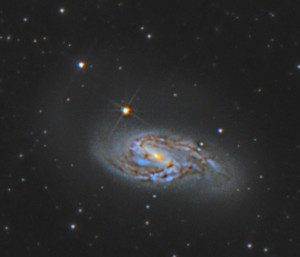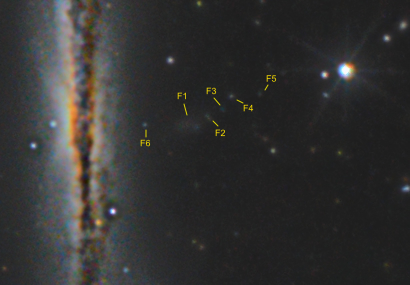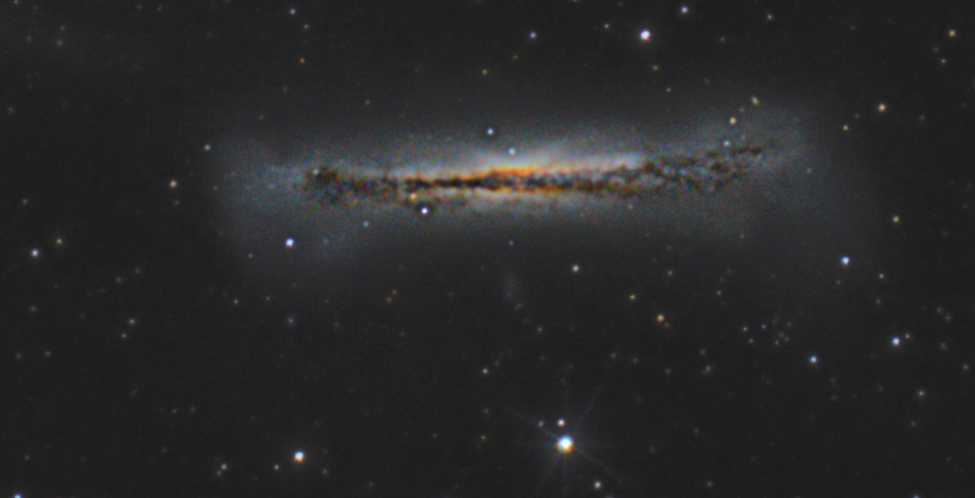Last weekend I was on an astrotrip to a nice spot in Germany with nice dark skies. The main goal of the weekend was to test all my new equipment and to see if imaging with the duo setup would work properly with the Lacerta MGEN controlling two camera’s. As a subject I chose the beautiful Leo Triplet, which is one of my favourite galaxy ‘groups. The three galaxies all show much detail and are quite big, so they really are an attractive subject to photograph. Next to details in the galaxies themselves, I wanted to see if I could capture the tidal tail of NGC 3628. Looking for images around the web, this seems like a tough nut to crack, as there are hardly any images with a good capture of it. But I like a challenge and this would be a good test for the Nikon D600.

As you can see in the result above, I didn’t succeed to get the tail to really stand out from the background, BUT….if you look careful you’ll notice it is definitely there.
Furthermore the faint halo around/above M66 is actually standing out really clear. I didn’t expect this as I didn’t really see this in pictures much as well.
Next to the three galaxies of the Leo Triplet, the images contains a lot more ‘faint fuzzies’ as you can see in the annotated version below (click for a bigger image);

So in the end I’m quite pleased with this image already, especially knowing there is still room for improvement as I’m still not using any flats, bias or dark frames and I probably should take longer exposures on subjects like this.
Imaging details:
Nikon D600, Newton 200 F5
NEQ6, guided with Lacerta MGEN
47x5min. ISO800
Processed in PixInsight
The Leo Triplet and this field of view is actually very interesting and has a lot going on. Let’s have a more detailed look into the three galaxies;
M65

M65 is located at a distance of around 35 million light years. It has little star formation and is low in dust and gas, which is interesting since it is almost the opposite situation of that of M66, it’s near neighbour.
DeepSkyVideos has made a very nice video featuring M65;
M66
M66 is about 95 thousand light-years across and has some very nice dust lanes and bright star clusters in it’s spiral arms.

In the image you can clearly see a faint ‘halo’ around the galaxy with two distinct bands above the galaxy that are clearly separated and almost look like very faint spiral arms. It looks like some sort of tidal tail to me, but I haven’t been able to find any information on this to confirm or give another explanation. Since this galaxy has been distorted by the interaction with NGC 3628, I think we can safely assume it to be a form of tidal tail. Please let me know if you know more about this in the comments below!
DeepSkyVideos also did a video on M66;
NGC 3628 – The tidal trail of Leo Triplet
NGC 3628, also called the ‘Hamburger galaxy’ or ‘Sarah’s galaxy’, is an unbarred spiral galaxy which we see edge-on. It shows a clear dark band right across the whole galaxy that is a band of dust situated at the outer edge of the arms of the galaxy. This band of dust is distorted at the end by the gravitational interaction of this galaxy with it’s two companions; M65 and M66. NGC 3628 has a tidal tail that is approximately 300,000 lightyears of length. A tidal tail is actually a region of stars and interstellar gas that extends into space from a galaxy. The tidal tail is caused by the galactic tide forces that occur when galaxies interact with another galaxy.

Another interesting feature of NGC 3628 is the fact that it has a jet of neutral hydrogen coming from it’s center along with two quasars that seem to be ejected out of the galaxy. In this jet there are two quasars that seem to have been ejected out of the galaxy’s center along with the plume. These quasars are not only aligned with the plume, but positioned at contour nodes. This is strongly indicative of physical association, and implies that these quasars and HI plumes have come out of NGC3628 in the same physical process. This is very interesting since the red shift of the quasars imply a very different distance for the quasars compared to NGC 3628 it self.
I’ve anoted a crop of my image of Leo Triplet to reflect the annotation of the official research paper: NGC 3628: Ejection Activity Associated with Quasars
F2 and F5 are the two quasars.
F1 “could represent entrained material in the ejection from the interior regions of NGC 3628 at about 11,000 km s−1 projected, or material of low intrinsic redshift or a mixture of both.” F2 is an X-ray quasar with a redshift of z=0.995. F3 is a double (seen as 1 object in my photo) irregular galaxy or knot. F4 is an elongated galaxy shape with redshift z=0.153 and F5 is the quasar with redshift z=2.15, lying at the end of the x-ray filament. All we know about F6 is that it is ‘blue and very compact’ and it needs further analysis.
I think it’s very cool to be able to capture details like this as an amature with very simple gear. Imaging and processing techniques sure have come a long way!

